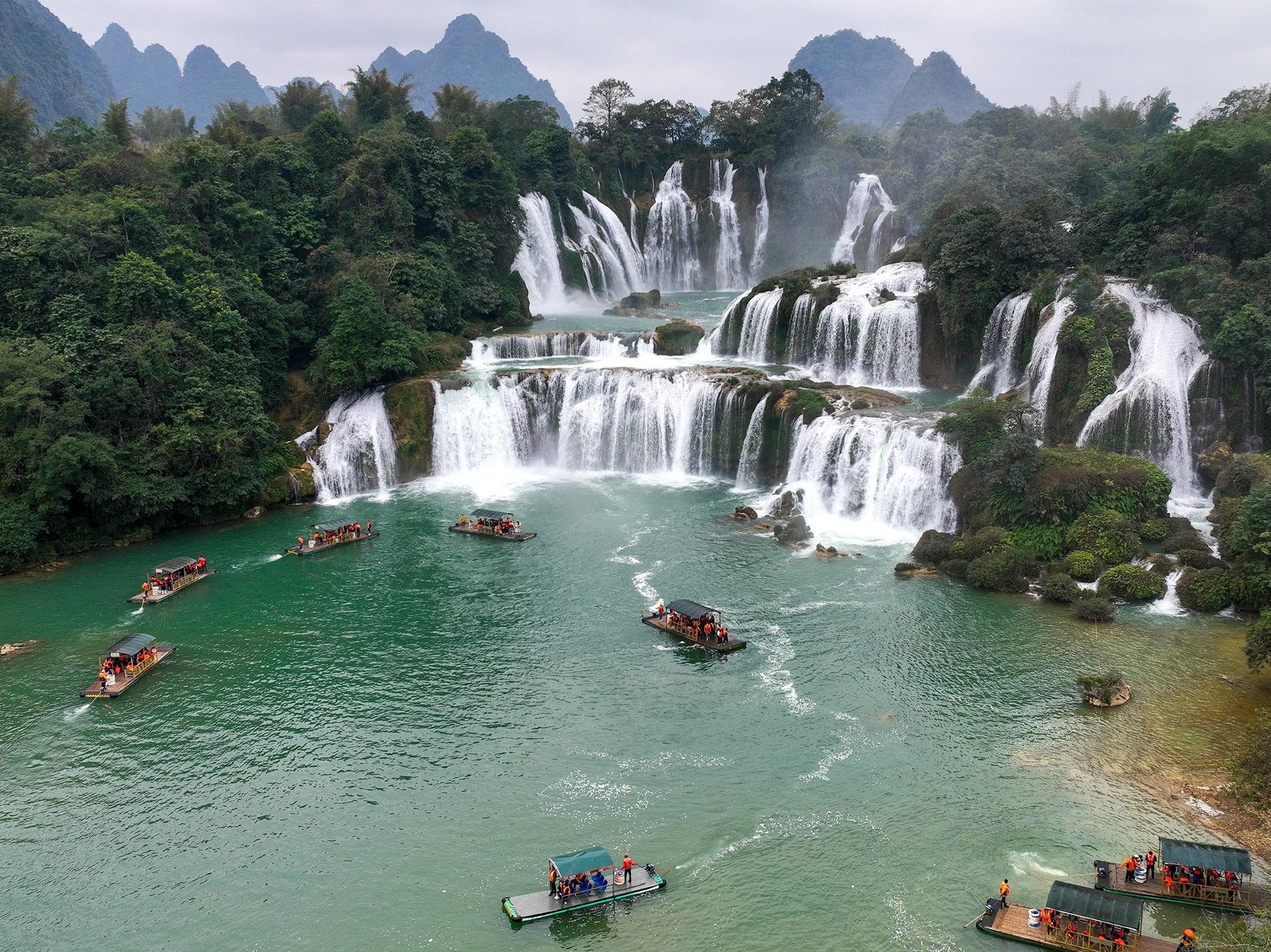 Tourists admire the Detian-Ban Gioc Waterfall from boats on the river in front of the natural wonder situated between Vietnam and China's Guangxi Zhuang autonomous region on Jan 23, 2023. (HE WENHUA / FOR CHINA DAILY)
Tourists admire the Detian-Ban Gioc Waterfall from boats on the river in front of the natural wonder situated between Vietnam and China's Guangxi Zhuang autonomous region on Jan 23, 2023. (HE WENHUA / FOR CHINA DAILY)
Chinese and Vietnamese travelers have been touring the Detian-Ban Gioc Waterfall area since it started receiving visitors in September.
Tourists from both countries have been able to reach the other side of the attraction across the border, thanks to the creation of a cross-border tourism cooperation zone that began a 12-month trial on Sept 15.
"The overall operational situation has been good," the Department of Culture and Tourism of Guangxi Zhuang autonomous region said in a statement.
As of Oct 29, a total of 50 Chinese tour groups with 572 people have entered the cooperation zone on the Vietnamese side. A total of 105 Vietnamese tour groups with 1,723 people have visited the Chinese side, the department said.
The trial operation is to work out how cooperative operation can be improved and lay a solid foundation for formalizing the operation, says Ban Huaqin, a senior official with the department.
Straddling the border between China and Vietnam, the Detian-Ban Gioc Waterfall is renowned for its spectacular views. It is the largest waterfall in Asia and the fourth-largest transnational waterfall in the world.
It is named Detian Waterfall on the Chinese side of the Guichun River in Chongzuo, Guangxi, while on the other side the Vietnamese call it Ban Gioc Waterfall.
During the trial operation, the zone is open to tourists who hold a Chinese passport or a People's Republic of China exit and entry permit, or a Vietnamese passport or a Socialist Republic of Vietnam exit and entry permit.
Visitors need to book in advance and join a group tour.
In the first three months of the trial, no more than 10 cross-border tours are allowed each day, and the size of a tour group is limited to five to 20 people. In the fourth month of the trial, total cross-border traveler numbers will be increased to 500, according to authorities.
"The cooperative area implements a management mode featuring pre-booked tours, limited group numbers, prescribed cross-border time, group entry and exit, and fixed tour routes," said Liu Gongbo, a Chinese guide who has led tours in the waterfall area.
Both China and Vietnam are responsible for arranging a full-time interpreter or leader to accompany each tour group, and the tour group organizer is responsible for collecting and keeping all the tourists' documents, Liu said.
"Chinese tourists visiting Vietnam should abide by relevant tourism regulations, behave in a civilized manner, and respect Vietnamese customs and habits," Liu added.
In 2015, the Chinese and Vietnamese governments signed an agreement on protecting and utilizing tourism resources surrounding the waterfall.
The Guangxi side conducted its own planning, but closely communicated with the Vietnam side in formulating the conceptual plan for the core area of the tourism zone, said Yu Fuhua, a senior researcher at the Guangxi culture and tourism department.
In February 2018, a fence enclosing the designated tourism cooperation area was completed. In December 2019, construction of the tourist inspection point, distribution center, and certification department were completed.
In December last year, the transportation hub for the cooperation area underwent major upgrades.
Hu Chao, a professor at Guangxi Minzu University's School of Economics, told China News Service that construction of the Detian-Ban Gioc Waterfall area was a landmark in cross-border tourism cooperation.
Integrating the tourism resources of the two countries for joint development is an important example of cross-border economic cooperation and cultural exchanges between China and Vietnam.
It also sets an example for promoting the joint construction of the Belt and Road Initiative and building a community with a shared future for mankind, Hu said.
The tourism zone will not only benefit the development and opening-up of tourism in border areas, but also be conducive to further promoting bilateral trade development, Hu added.
China's border areas have rich tourism resources, and the tourism cooperation zone can offer references on how to jointly develop them into areas of economic value, Hu said.
Chinese authorities said more efforts will be made to upgrade transportation services, such as buses, to connect popular tourist attractions in Chongzuo to the waterfall area.
Shi Ruipeng contributed to this story.


